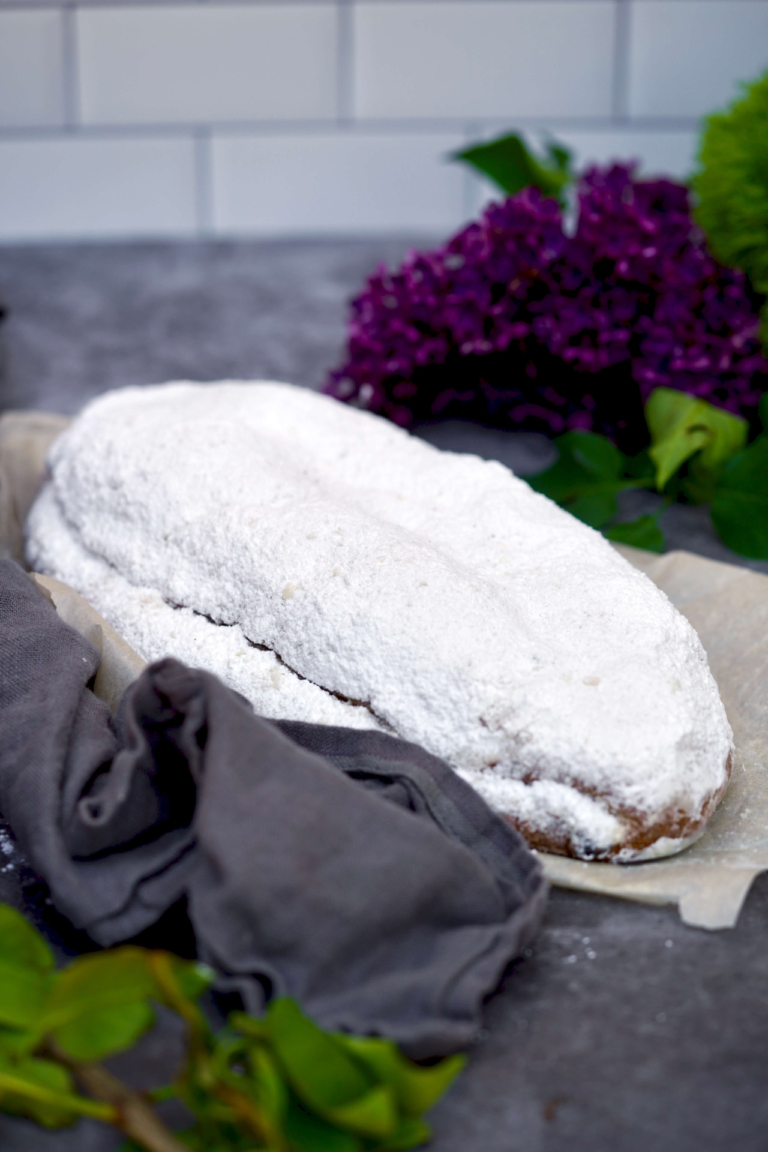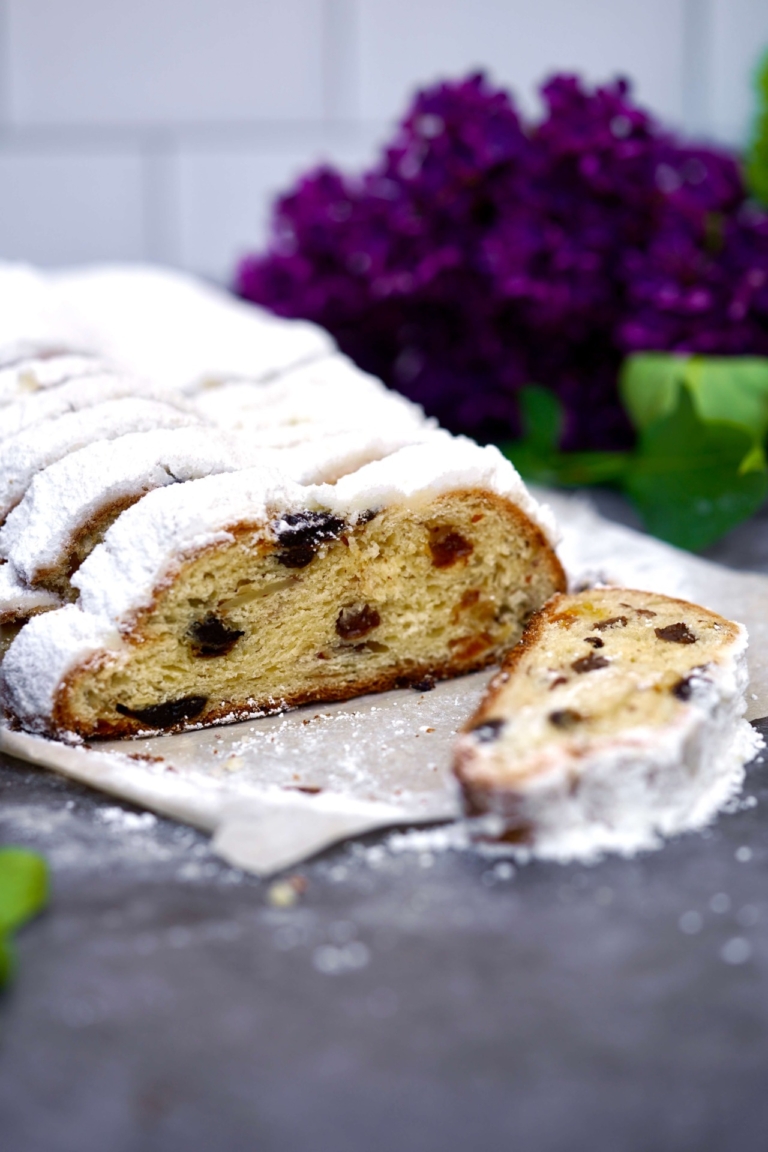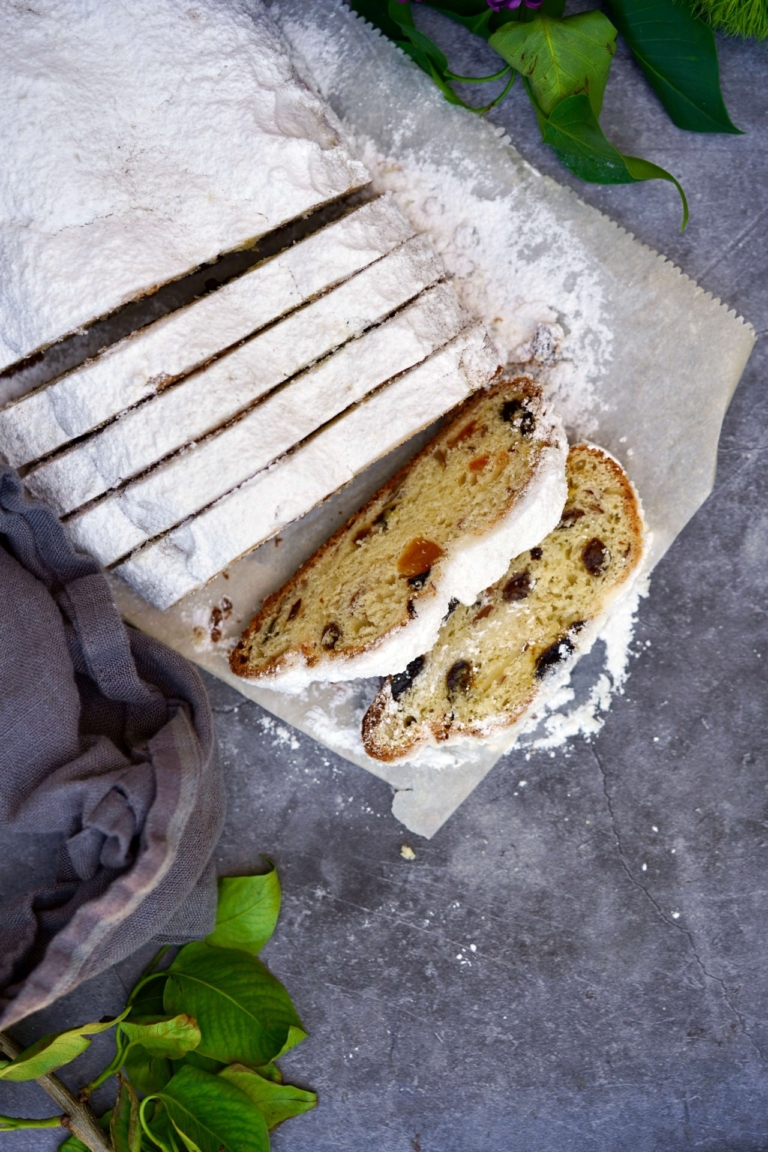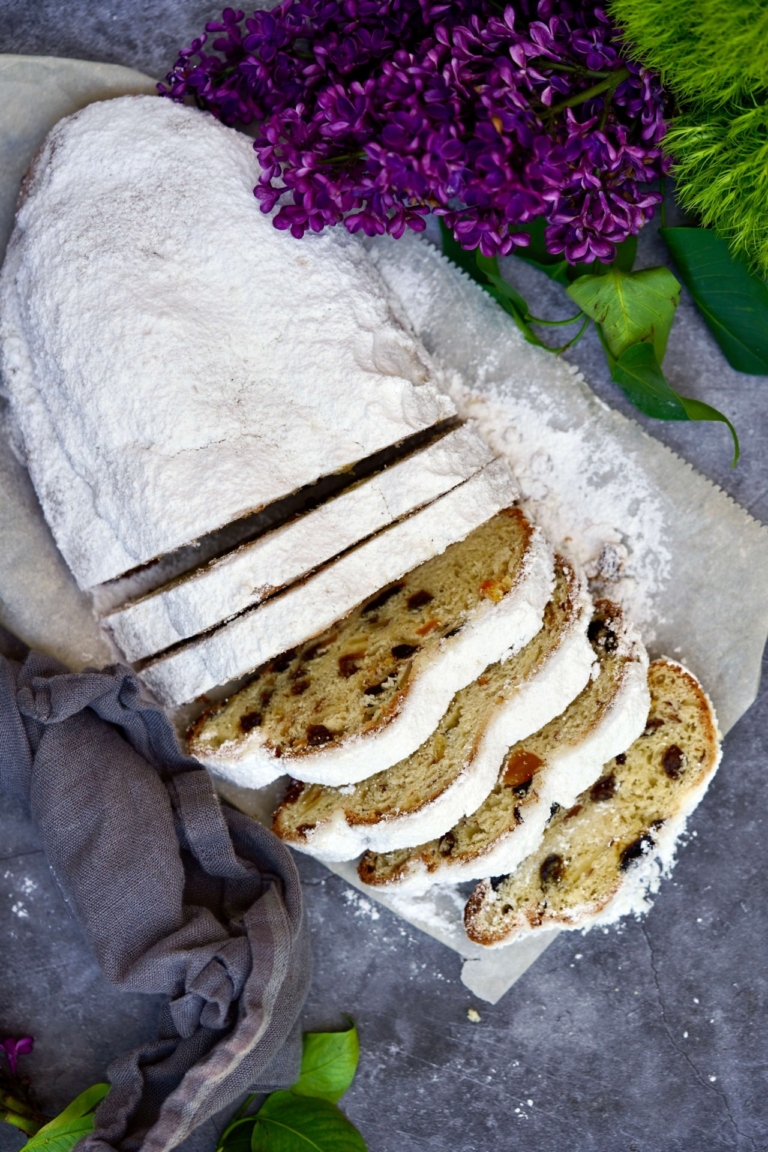Christmas Stollen

German Stollen, also called “Christstollen” has been around for nearly 700 years and is considered one of the most famous Christmas treats. Sweet bread and cakes flavored with candied fruits and nuts are perhaps the hallmarks of the Christmas baking season in many countries around the world. Examples of this include; fruitcakes which are traditional throughout the English-speaking nations, panettone in Italy, keks in Poland, julekake in Norway, bolo-rei in Portugal, and birnenbrot in Switzerland. But perhaps the most famous throughout the world is the German Stollen.
What Is Stollen?
Stollen is a yeast bread that is baked with dried fruits, candied citrus peel, nuts, and spices. A traditional Stollen is always dusted with a thick coating of powdered sugar, which is said to represent the snowy German landscape, and baked with spices conveying the warmth of the Christmas season. Despite my German heritage, I had never made a stollen, so developing this stollen recipe was a fun experiment for me.
How Stollen Got Its Name
The word “Stollen” was a word for a post or boundary stone for a city. “Striezel” is a word for loaf, and the shape of the bread along with being dusted with powdered sugar was a symbolic shape of the baby Jesus in swaddling clothes so it was also called Christstollen.
The History of Stollen
There are several different versions of stollen: Mandelstollen (almond), Mohnstollen (poppy seed), Quarkstollen (quark), Nuss-Stollen (nuts), Butterstollen (high butter content), Dresdner Stollen (raisin) and Marzipanstollen (marzipan). The first and most famous variety of stollen is by far the Dresdner Christstollen. Some historians date its origin to the early 1300s and over the centuries the stollen was refined to become what it is today.
Stollen And The Butter Ban
But stollen was not always as delicious as it is today. Original stollen recipes were often bland and made of hard pastry mainly because the Catholic Church forbade the use of butter and milk during Lent). It was in this year that Prince Ernst von Sachsen, at the request of the bakers of Dresden, petitioned the pope to lift the butter ban. The request was denied and then, five popes later, the ban was finally lifted in 1490 via the pope’s famous Butterbrief, “butter letter.”
From that point on, stollen gradually developed into a delicious sweet bread with added ingredients and it soon became an important symbol of the region. Germany’s first Christmas market was held in Dresden in 1434. This market, the Dresdner Striezelmarkt, is still held every year.
Are Stollen And Fruitcake The Same?
How To Serve Stollen
What To Drink With Stollen
- Coffee
- Mulled wine
- Schnapps
- Riesling
- Rum
- Cognac
- Amaretto
If you’ve never tried your hand at making homemade Stollen, trust me, it’s a worthy endeavor. In the recipe, I skip the marzipan and use a mixture of raisins, apricots, cherries, and orange peel to make a moist, flavorful, and unforgettable Christmas bread you just may crave year-round.
Christmas Stollen
Ingredients:
For the Sweet Dough:
- 4 tablespoons sugar, divided
- 1/4 cup warm water
- 1 package of dry active yeast
- 3 cups all-purpose flour
- 1/4 teaspoon salt
- 3/4 cup unsalted butter, cut into small cubes
- 2 eggs
- 1/2 cup sour cream
- 1 teaspoon vanilla extract
For the Stollen:
- 3/4 cup dark raisins
- 1/4 cup dried apricots
- 1/4 cup dried cherries
- 1/2 cup candied orange peel
- 1/2 cup brandy
- 1/3 cup plain or lightly toasted sliced almonds
- 6 tablespoons unsalted butter, melted, divided
- Confectioners' sugar, for dusting
Directions:
- For the Sweet Dough: First, place the raisins, apricots, cherries, and candied orange peel in a small bowl. Add the brandy and allow to plump while you make the sweet dough. By the time you are done making the dough, the fruit will be ready.
- In a small bowl mix the warm water (about 110 degrees F), and 1 tablespoon of sugar. Sprinkle the yeast on top, do not mix, cover with plastic wrap and let stand for 5 minutes. Uncover and mix to blend. Cover again and allow to sit a few minutes more until bubbly.
- In the bowl of a kitchen mixer, such as a Kitchen Aid, fitted with a paddle attachment, add the flour, and the remaining 3 tablespoons of sugar and salt. Mix on low. Add the butter and continue to mix until crumbs begin to form about 3 minutes. Turn the mixer off.
- In a small bowl mix together the eggs, sour cream, and vanilla extract, and blend. Turn the mixer back on and add the egg mixture to the flour mixture. Next, add the yeast mixture and mix on low until a soft dough forms. Wrap the dough in plastic wrap and refrigerate for about 30 minutes until ready to use.
- For the Stollen: Once the fruit is plumped and the dough is resting, drain the brandy from the fruit. Blot the fruit slightly with a paper towel and roughly chop. Set aside. Remove the dough from the refrigerator and allow to warm up slightly.
- Line two sheet pans with parchment paper and place them near your workstation.
- Divide the dough in half. On a lightly floured work surface, working with one half at a time, gently knead in half of the chopped fruit and half of the sliced almonds. With a well-floured rolling pin, roll out the dough into a larger 8x12-inch oval, keeping the longer 12-inch side parallel to the counter edge.
- Using the rolling pin, or the handle of a wooden spoon, make a slight depression/dip lengthwise slightly off-center in the dough. Fold the other side up over the dough with the edge ending in the depression forming more of a semi-circle leaving about 1 inch of the bottom half exposed.
- Place the stollen on the prepared baking sheet. Repeat the above process with the remaining dough. Cover both loaves with a tea towel and allow to rest in a warm spot for 1 hour.
- Preheat the oven to 375 degrees F. Using a pastry brush, gently brush the loaves of bread with melted butter. Place in the oven and bake for about 20-25 minutes, rotating the sheet pans midway through the baking process. Remove from the oven and brush with the remaining melted butter, dust with confectioners sugar. When the stollen are completely cool, dust again generously with additional confectioners sugar to fully coat.







